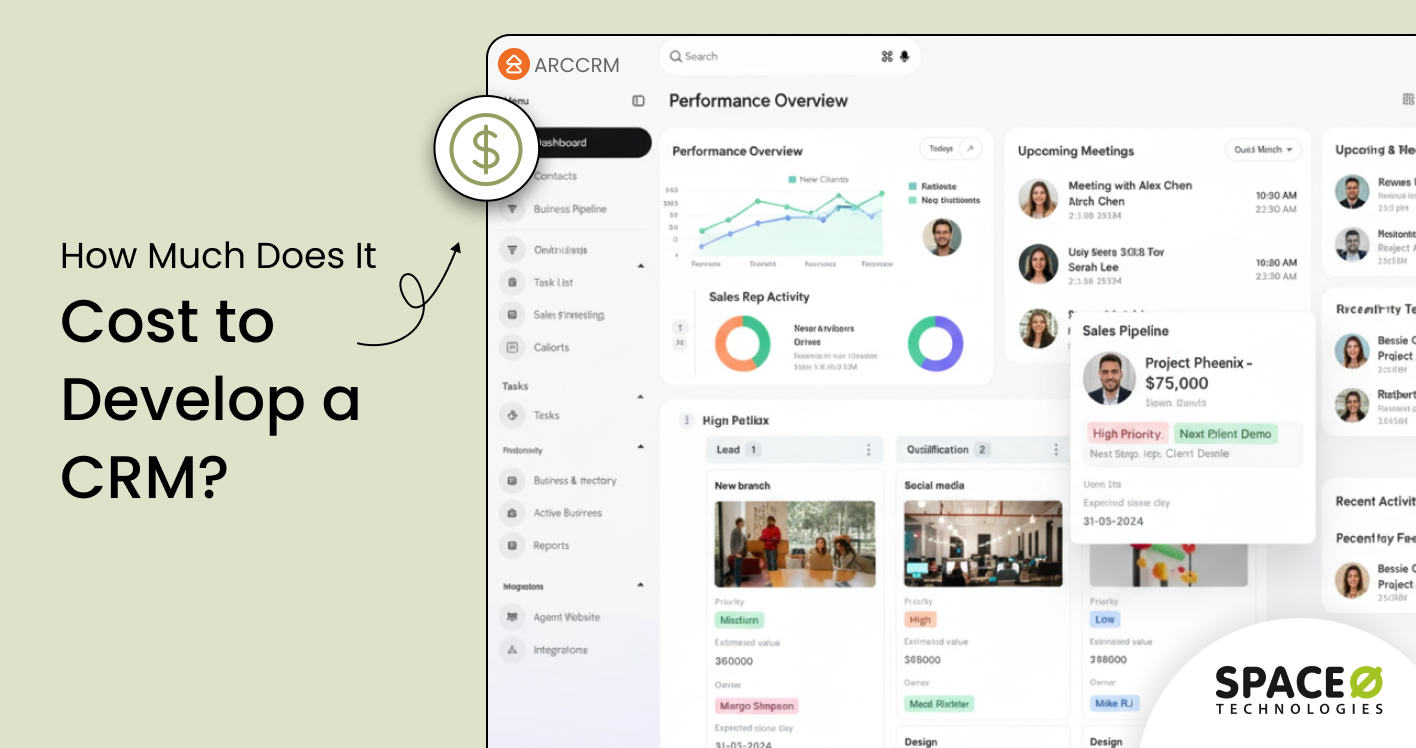Building a custom CRM solution can transform the way your business manages leads, sales, and customer relationships. But before you dive in, one question dominates every decision-maker’s mind: how much will it actually cost?
Whether you’re a business owner, CTO, or project manager, understanding the price of a custom CRM is crucial for budgeting, planning, and ensuring a strong return on investment. From the features you choose to the technology stack and integrations, several factors influence the overall cost.
This guide breaks down everything you need to know about custom CRM development costs, helping you make informed decisions and plan your project without surprises. We compiled our knowledge as a leading CRM development company to help you determine the average cost of building a CRM based on different factors and strategically plan your budget.
Table of Contents
Custom CRM Development Cost Overview
Custom CRM development typically costs between $25,000 and $300,000, with most projects landing in the $50,000 to $150,000 range. The software development cost depends on how many features you want, which systems you’re connecting to, and whether you’re building something simple or enterprise-grade with AI capabilities.
Entry-level solutions: $25,000–$50,000
Developing a CRM that just covers the basic features (contact management, task tracking, and simple reports) generally costs less. You get a digital address book that actually works for your business, without the complexity of automation or advanced analytics. Development takes about three to four months with a small team.
Mid-range solutions: $50,000–$150,000
Mid-range systems add workflow automation, customizable dashboards, mobile apps, and connections to your existing tools like email platforms or accounting software. Think automated lead assignment, visual sales pipelines, and different access levels for different team members. Projects at this level run four to eight months and involve backend developers, frontend specialists, and quality assurance engineers.
Advanced solutions: $150,000–$300,000
Advanced platforms bring in AI-powered lead scoring, predictive analytics, deep customization, and integration with multiple enterprise systems. You might get custom modules for healthcare compliance tracking or real estate property management. Development stretches to eight to twelve months and requires machine learning expertise and complex system architecture knowledge.
Enterprise solutions: $300,000+
Enterprise systems serve large organizations with multiple locations, complex approval workflows, advanced security, and connections to legacy systems. Picture thousands of users working simultaneously, massive data volumes, territory management, commission calculations, and multi-currency support. Projects take twelve months or longer with dedicated teams specializing in enterprise architecture.
This overview gives you an idea of the overall CR development costs. Next, let’s explore the major factors that influence the cost of a custom CRM.
Get Your Free Custom CRM Quote
Share your CRM software vision with our experts and get a detailed, no-obligation estimate for your CRM project. Plan confidently with a personalized quote today.

Major Factors That Influence CRM System Cost
Six main factors determine what you’ll spend on custom CRM development. Each one affects your budget differently.
Feature scope and complexity
Every feature adds development hours, but advanced functionality like AI recommendations or complex business rules takes exponentially more time than basic data entry forms. A contact form might take days, while an intelligent lead routing system, considering multiple variables, could take weeks.
UI/UX design requirements
Pre-made interface components cost less, but a custom design reflecting your brand and creating intuitive experiences requires specialized designers and extra time. Making everything work smoothly across desktop, tablet, and mobile adds another layer.
Integration requirements
Each connection to another system—accounting software, marketing platforms, support tools—requires custom API development, data mapping, and testing. Some integrations are straightforward with well-documented APIs, while others involve legacy systems lacking modern connection capabilities.
Security and compliance needs
Industry regulations like HIPAA for healthcare or GDPR for European customers require extra security measures, audit logging, and specific data handling protocols.
Scalability planning
Building for 10 users differs dramatically from designing for 1,000 users with plans to reach 10,000. Scalable architecture requires careful database design, caching strategies, and infrastructure planning from the start.
Testing and quality assurance
Comprehensive testing across devices, browsers, and use cases prevents expensive post-launch fixes. Automated testing frameworks cost more upfront but reduce long-term maintenance expenses.
Now that we’ve explored the key factors affecting CRM development costs, let’s compare how different deployment models, cloud, on-premise, and hybrid CRM systems, impact your overall investment.
Cost Comparison of Cloud, On-Premise, and Hybrid CRM
Where you host your CRM affects both upfront costs and ongoing expenses. Each deployment model offers different advantages. Here’s how different deployment strategies impact CRM development pricing:
Cloud: Pay-as-you-grow model
Cloud-based systems minimize initial infrastructure investment since you’re using existing platforms like AWS, Azure, or Google Cloud. Monthly hosting fees typically start around $500 to $2,000 for mid-sized deployments and scale with usage.
You get automatic updates, built-in redundancy, and flexibility to adjust resources based on demand, though you’re dependent on internet connectivity and paying ongoing subscription costs.
On-premise: Upfront investment model
On-premise deployment means purchasing server hardware, setting up your own data center or server room, and maintaining IT infrastructure internally. Initial hardware costs range from $10,000 to $50,000 or more, plus ongoing maintenance, electricity, and dedicated IT staff.
You gain complete control over your data and potentially lower long-term costs if you’re maintaining the system for many years.
Hybrid: Best of both approaches
Hybrid models let you keep sensitive customer data on-premise while using cloud services for less critical functions like reporting or mobile access. This balances security concerns with operational flexibility, though it introduces architectural complexity and requires careful synchronization between environments. Development costs run 15% to 25% higher than pure cloud or on-premise solutions.
With deployment models clarified, the next step is to examine how key features and integrations influence the total cost of your custom CRM, helping you understand where your investment is going.
Price Impact of Key Features and Integrations
Specific features carry different price tags based on technical complexity and specialized expertise required. Here are the most common CRM features and how they impact the cost of developing a CRM software:
- Automation and workflow engines: Custom business rules that automatically route leads, trigger follow-up tasks, or escalate deals based on specific conditions typically cost $8,000 to $25,000, depending on complexity.
- Analytics and reporting dashboards: Real-time data visualization with customizable reports, drill-down capabilities, and export functions add $5,000 to $15,000, while advanced predictive analytics can reach $20,000 to $40,000.
- AI-driven lead scoring and chatbots: Machine learning algorithms analyzing customer behavior patterns and predicting conversion likelihood start at $15,000 and can exceed $50,000 for sophisticated implementations.
- Mobile apps and offline access: Native iOS and Android applications with data synchronization effectively double your development timeline since you’re building three separate interfaces, adding $30,000 to $80,000.
- Industry-specific modules: Custom features for specialized industries like appointment scheduling for healthcare or property listing management for real estate add $10,000 to $40,000.
- API and ERP integration layers: Connecting your CRM to enterprise resource planning systems, accounting platforms, or marketing automation tools typically costs $3,000 to $12,000 per integration.
While features and integrations make up a large part of the budget, there are also hidden costs to consider, such as CRM implementation, data migration, and ongoing support, which can impact your overall investment. The coming section highlights these factors.
Build Your CRM Within Budget
With 15+ years of experience and a track record of serving 1200+ clients, we help businesses develop a custom CRM that meets your business needs while keeping costs under control.
Hidden Costs of CRM Implementation, Data Migration, and Support
Beyond development costs, several overlooked expenses affect your total investment.
User training and change management
Your team needs to learn the new system, which means creating training materials, conducting workshops, and providing support during the transition. Organizations typically spend 10% to 15% of the development cost on comprehensive training programs.
Database and storage migration
Moving customer data from spreadsheets, old CRM systems, or multiple disconnected databases requires data cleaning, format conversion, and validation. Migration projects range from $5,000 for simple transfers to $30,000 or more for complex multi-source consolidation with extensive data quality issues.
Legacy system decommissioning
Safely retiring old systems while maintaining data accessibility for historical records can add $3,000 to $10,000 to your project.
Ongoing maintenance and SLA
After launch, you’ll pay for bug fixes, security updates, performance optimization, and feature enhancements. Most businesses budget 15% to 20% of the initial development cost annually for maintenance and support services.
Beyond hidden expenses, the location and engagement model of your development team can significantly influence CRM development rates, making it an important factor to consider when planning your budget.
Development Team Location and Engagement Model Rates
Where your development team is located dramatically impacts hourly rates and total project costs. Lower rates don’t always mean lower total costs if communication challenges extend timelines. Here’s how much it costs to hire software developers in different regions:
| Region | Hourly Rate | Key Considerations |
|---|---|---|
| North America & Western Europe | $100–$200 | Easier communication, cultural alignment, and convenient time zones |
| Eastern Europe & Baltic States | $40–$80 | Strong technical education, manageable time differences (6–8 hour overlap) |
| Latin America | $35–$70 | Significant time zone overlap for North American clients, cultural similarities |
| South & Southeast Asia | $20–$50 | Most cost-effective, but 10–12 hour time differences require asynchronous communication |
Having explored how team location and engagement models affect development rates, let’s look at seven proven ways to reduce custom CRM development costs while still building a robust, high-quality system.
Seven Proven Ways to Reduce Custom CRM Development Cost
Strategic planning and smart development choices can significantly reduce your investment without sacrificing essential functionality.
Define a lean MVP roadmap
Start with the minimum feature set, solving your core business problem: contact management, basic pipeline tracking, and essential reporting. Add advanced features in subsequent phases once you’ve validated the system with real users. MVP development costs are typically 40% to 60% less compared to building everything upfront.
Prioritize must-have features
Distinguish between features you need on day one versus nice-to-have functionality that can wait. Every feature you defer to phase two reduces development time, testing requirements, and project complexity.
Reuse open-source and existing libraries
Established frameworks and component libraries have been tested by thousands of developers and provide reliable functionality. Using proven solutions for common features like authentication, file uploads, or chart generation can reduce development time by 30% to 40%.
Adopt agile iterations and continuous feedback
Regular review cycles every two weeks let you catch issues early, adjust priorities based on real feedback, and prevent expensive late-stage changes. This iterative approach reduces wasted development effort on features that don’t meet actual user needs.
Leverage offshore development pods
Carefully vetted offshore teams can deliver quality work at 40% to 60% lower costs than domestic developers. The key is selecting partners with strong portfolios, clear communication processes, and proven track records rather than choosing the lowest bidder.
Automate testing and deployment pipelines
Automated testing catches bugs immediately when code changes, while continuous deployment pipelines reduce manual release work. The upfront investment in test automation pays back quickly by reducing quality assurance time and preventing regression bugs.
Plan for phase-wise scaling
Design your system architecture to support future growth, but implement advanced scalability features only when you actually need them. This avoids over-engineering while ensuring you won’t need expensive rewrites as your user base grows.
Once you know how to optimize development costs, it’s essential to evaluate the bigger picture by calculating the ROI and total cost of ownership of your custom CRM.
Calculating ROI and Total Cost of Ownership
Looking beyond initial development costs helps you understand the true financial impact of your CRM investment over its useful lifetime.
Short-term vs long-term cost perspective
A custom CRM with $100,000 initial development costs and $15,000 annual maintenance totals $145,000 over five years. Compare this to a SaaS solution at $100 per user monthly for 20 users, which costs $24,000 annually and reaches $120,000 over the same period.
Payback period benchmarks
Most businesses see CRM payback within 18 to 36 months through increased sales efficiency, better customer retention, and reduced administrative overhead. Track metrics like sales cycle length, lead conversion rates, and customer lifetime value to measure actual returns.
Impact on customer retention and revenue
Effective CRM systems improve customer retention through better relationship management and proactive engagement. Since acquiring new customers costs more than retaining existing ones, even modest retention improvements generate substantial returns.
Build a Powerful CRM Within Budget with Space-O Technologies
Understanding the cost of custom CRM development is key to making informed business decisions. The total investment depends on features, integrations, technology, and long-term maintenance.
But, when planned strategically, a custom CRM can significantly boost productivity, streamline workflows, and improve customer relationships. By evaluating costs carefully, you ensure your CRM delivers maximum value while staying within budget.
At Space-O Technologies, we make CRM development simple and reliable. With 15+ years of experience and a record of serving 1200+ clients globally, we help businesses of all sizes design, develop, and implement custom CRM solutions that fit their unique needs.
Our team ensures your project stays on schedule and within budget, delivering scalable, secure, and feature-rich CRM systems that drive measurable results.
Ready to take the next step? Book a free consultation with our experts today and get a free, no-obligation quote for building a CRM solution.
FAQs About Custom CRM Development Cost
How long does it take to build a custom CRM?
Development timelines range from three months for basic systems with core features to twelve months or more for enterprise platforms with extensive customization and integrations. Most mid-range projects with workflow automation and several integrations take five to eight months from initial planning through deployment.
Is a custom CRM more expensive than an off-the-shelf CRM?
A custom CRM generally has a higher upfront cost compared to off-the-shelf solutions because it’s tailored to your specific business needs, workflows, and integrations. While off-the-shelf CRMs often come with fixed subscription fees, custom development requires investment in design, development, testing, and deployment.
However, a custom CRM can provide long-term value that off-the-shelf options can’t always match. It scales with your business, integrates seamlessly with your existing tools, and eliminates unnecessary features you don’t need. Over time, this can result in higher efficiency, reduced operational costs, and a better ROI, making the investment worthwhile for many businesses.
What hidden costs should I consider in CRM development?
When planning a custom CRM, it’s important to account for costs beyond just development:
- Post-launch upgrades: Adding new features or modules as your business grows
- Third-party integrations and API licensing: Some integrations may have separate costs
- Maintenance and support: Security updates, bug fixes, and server hosting
- Training and onboarding: Helping your team use the CRM effectively
- Data migration: Moving existing customer data into the new system
By factoring in these hidden costs early, you can create a more accurate budget and avoid unexpected expenses, ensuring your CRM project stays on track.



